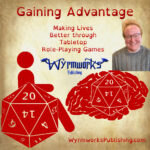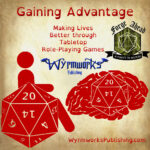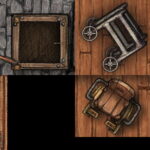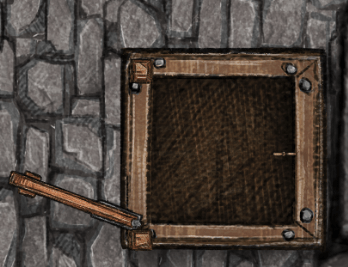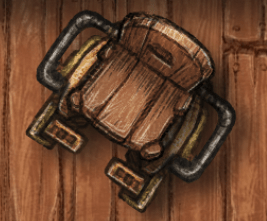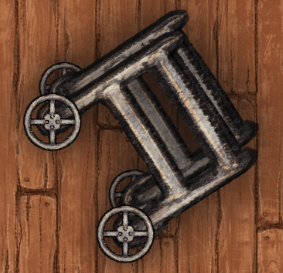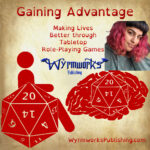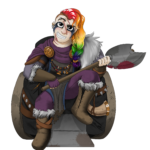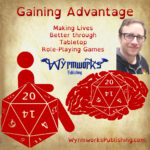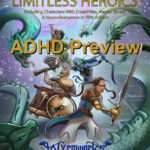When Jennifer Kretchmer presented the scandalous idea of ramps in dungeons in Candlekeep Mysteries, a significant portion of the D&D community couldn’t wrap their mental dice bags around such a concept. It seemed incomprehensible to make dungeons more accessible, and I still get multiple daily angry or derisive comments to that effect whenever I run Facebook ads promoting our products.
But just as curb cuts, those little ramps in sidewalk curbs, were designed for wheelchairs but benefit strollers, shopping carts, bicyclists, and anyone else who uses wheels, including them in dungeons may be more sensible than stairs, regardless what adventurers may come investigating.
So since I get tired of writing the same responses repeatedly, as do others who fight for accessibility and disability representation, consider these concepts, and feel free to comment below.
1. Are dungeons supposed to be inaccessible?
Dungeons are designed to keep people out!
Are they, though? That depends on the dungeon. It’s a generic term that can refer to any number of structures for any number of purposes. Often, a dungeon is a space that has either intentionally or naturally changed purpose over time. Maybe it was once a castle basement used for storage or as a siege shelter. Or a crypt. Or a cave. Or a menagerie. Or a majestic castle. Or a forest in the Feywild. When considering the accessibility of a dungeon (or any other details in its design), the designer must consider its purpose, its owner, its age, its ecology, and many other factors. But while the 10’×10′ stone corridor underground is still a staple, it hardly represents the majority of adventuring environments in D&D.
2. Are dungeons all made from flagstone?
Flagstone, made typically from sandstone or similar materials, is the classic material design for a dungeon, but a dungeon can be packed dirt, a tunnel carved out of a mountain, the alleys in the darker sections of Waterdeep, massive caverns in the Underdark, the City of Brass on the Elemental Plane of Fire, a rickety old wooden mansion, or the rubble of ancient ruins. Each of these presents accessibility challenges to different characters — my tiefling warlock with chronic leg pain will manage a whole lot better than an able-bodied elf druid in the City of Brass, and if the steps in the haunted mansion suddenly become a slide, the walking character will be prone while the wheelchair user holds out a spear and yells, “Charge!”
3. What was the dungeon before it was haunted ruins?
How many people are specifically building dungeons, anyway? They’re difficult to make and not particularly practical. Most dungeons used to be something else (or still are). The dragon isn’t going to build human-sized steps into its lair. A xorn digging through the Elemental Plane of Earth will create smooth tunnels. Water eroding an ancient cavern won’t erode at jagged 90° angles. An ancient dwarven mine would never have stairs (and may even have cart tracks or elevators). And the inside of a crashed spaceship will have smooth hallways and elevators. That doesn’t preclude the possibility of steps, a stone cliff (which is difficult for anyone but the rogue or monk to climb), or other obstacles, but if you can creatively find a way to cross that pit filled with a gelatinous cube, you can bet that a seasoned adventurer has some tricks up their sleeve to overcome occasional rough terrain.
4. Have you ever tried carrying an occupied coffin down stairs?
Many dungeons were or are still crypts designed either for a wealthy family or to keep an ancient evil contained. If the current occupant came into that crypt in a pine box, you can bet there’s a ramp. I’ve attended and conducted dozens of funerals, and there’s a reason modern morticians use carts for coffins — they’re heavy, especially with a body in them! (And the bigger the corpse, the heavier.) So if you’re carrying that coffin to its (hopefully) final resting place, guiding a cart into an underground crypt on a ramp with a rope will save you a whole lot of effort, even if there’s also steps beside the ramp, either permanently or in the form of nearby removable timbers. A party coming to investigate a restless spirit would likely find the accommodations designed by the architect or implemented by a past undertaker.
5. What size creature were your stairs designed for?
Stairs are designed for the people using them, so modern stairs are designed for a human range of heights and foot sizes. But if a dungeon occupied by both a clutch of kobolds and a family of ogres will either require the kobolds to bring climbing gear to scale ogre-sized steps or the ogres to walk sideways up the steps, even then with a lot of foot pain. A ramp easily solves this problem, not to mention making it easier to drag in fresh meat from a successful hunt or drag out bags of bones of unsuccessful adventurers.
6. How do you feed your monsters?
Speaking of dragging carcasses, you need to feed that hydra that’s somehow in a chamber with only 10’×10′ corridor access and dispose of its waste. While I recommend an underground river or other sewage drain for the latter (which can be its own security problem when kobolds find it), unless you have a city’s worth of really gullible bullywugs that are willing to go investigate the noises that you insist are coming from a carnival with dragonfly ripple ice cream, you’re going to need to kill something and transport it into those snapping jaws, and you’ll have a much easier time pushing it over a ramp than stairs.
7. How did all those stones, trap mechanisms, and monsters get down there?
You know that big treasure chest full of gold and jewels? Yeah, it’s probably a mimic. But if it’s not, good luck lugging that thing down steps into the deepest chamber. Add tons of flagstone, support timbers, cages filled with monsters, chests of potions bottles, or whatever else you’re storing down there. Put those containers on wheels down a ramp, and your building process will be a lot easier.
8. Which lasts longer in treacherous environments, stairs or ramps?
As noted above, flagstone is usually made from sandstone. Sandstone erodes. That’s how sedimentary rock forms. If that ancient staircase is as ancient as you describe, it’s probably a ramp by now, albeit irregular, which would be even easier to navigate if it has some landings.
9. Dwarves had specific skills to detect ramps as early as 1st Edition.
In AD&D, dwarves could, “Detect grade or slope in passage: 1-5 on 1d6.” In other words, ramps in underground passages aren’t some new 5e concept — they’re oldschool. Some were gradual, thus the check, and some were more obvious, but they had this skill in the first place because when you’re digging a mine or underground city and need to move a lot of rock and goods around, slopes make a lot more sense than steps. And elevators, even better. And purple worms don’t burrow in straight lines.
10. It’s fantasy but makes the real world better.
All this fantasy talk is fun, but real lives are the most important factor. Discussions of “realistic” in a world where a spoken word can transform steps into a ramp or a mudslide or a mimic or a dimensional gateway, what matters most is the effect on our players. Even if a disabled player doesn’t want to play a disabled character, including disabled NPCs and the effects of their existence in your world tells your players, “I don’t want to imagine a world without you in it.”
